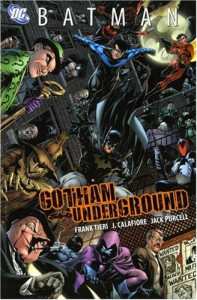 The problem with a story arc like Gotham Underground is that, by itself, it doesn’t really get to go anywhere. Instead, it’s tied into and supports the continuity of a larger limited series/crossover event/superhero throwdown, and as such what happens in it isn’t as important as the fact that it moves the continuity from point A to point B. In this case, the continuity in question relates to the Infinite Crisis and Fifty Two crossovers, leaving Gotham Underground essentially caught in the middle.
The problem with a story arc like Gotham Underground is that, by itself, it doesn’t really get to go anywhere. Instead, it’s tied into and supports the continuity of a larger limited series/crossover event/superhero throwdown, and as such what happens in it isn’t as important as the fact that it moves the continuity from point A to point B. In this case, the continuity in question relates to the Infinite Crisis and Fifty Two crossovers, leaving Gotham Underground essentially caught in the middle.
The premise is interesting enough: what happens to Gotham City’s criminal underworld once The Black Mask goes down for the long count. It’s certainly a noteworthy question, particularly considering how thoroughly Gotham is populated with supervillains, costumed psychotics, mob familes, and plain old thugs. Complicating matters, there’s a new player on the scene, the aptly named Tobias Whale, who’s just moved operations from Gotham and who has a serious hate on for anyone wearing a mask. Whale quickly moves to take over Gotham’s organized crime while simultaneously ridding the city of costumed villains. Meanwhile, the Penguin is using his club to funnel supervillains to the Suicide Squad, which is kidnapping them and sending them to a labor camp on another planet, and Batman has gone incognito as mobster “Matches” Malone, who then gets sent to jail and set up for murder on the orders of Bane, who’s now a member of the Suicide Squad and isn’t fooled by the disguise, even as the extended Bat-family is caught trying to cover for Batman and face off a slew of villains as Intergang, the crime syndicate founded by Darkseid, moves into Gotham with one of Whale’s former henchmen as point.
Did I mention that the Riddler’s tied up in all this in his new role as a private investigator? Yeah, it’s that complicated, and that’s before throwing in the wholesale attempt to create new supervillains with leftover villain tech, the somewhat awkward plotline derived from the secret hospitalization of Great White Shark, and Nightwing’s own ill-fated undercover operation wherein he runs afoul of the latest incarnation of Vigilante.
All of this is, of course, a roundabout way of saying that the plot is far too complictated for reasons that probably had a lot more to do with the larger DC continuity than with the events of Gotham Underground themselves. Had the story restricted itself to the battle to take over Black Mask’s holdings, and the street-level conflict thereof, then a tight, taut Batman story might have emerged. Instead, Gotham Underground is overstuffed with every villain imaginable (along with a few, like Killer Moth, who never should have been imagined in the first place) and umpty-zillion plotlines that don’t really go anywhere.
Where the writing shines, though, is in the small moments — Robin and Commissioner Gordon’s exchanges by the Bat-signal beacon, Riddler and Penguin admitting that they enjoy each others’ company because none of the other Arkham regulars can hold a coherent conversation, and suchlike. Tieri’s characterizations of the old villainous standbys are subtle and fun; it’s just when the plot machine starts cranking that things get less interesting.
As for the art, it’s positively vibrant, with bright colors that fairly leap off the page — not what you’d necessarily expect from a tale of gangland warfare. Of particular interest is the panel layout, which in places evolves into a jigsaw shape, the better to pass along elements of the various puzzles being unraveled. The fact that Calafiore can visually juggle such a large cast — and so many group fight scenes — is impressive, and the massive throwdowns don’t descend into the overly populated muddle they might have otherwise.
Ultimately, Gotham Underground is fun but slight, a too-complicated treatment of a cool idea that would have benefited from a streamlined approach. Batman and continuity completists will enjoy it, others might find themselves bewildered by the cast of thousands and innumerable interwoven subplots.
(DC Comics, 2008)
